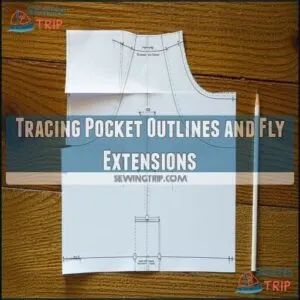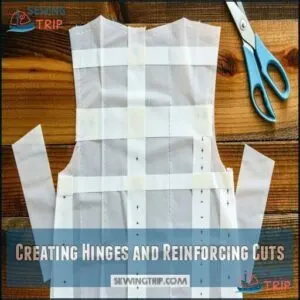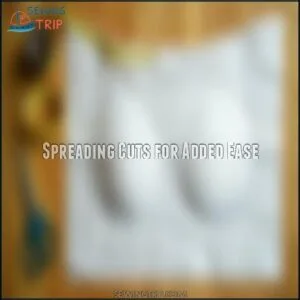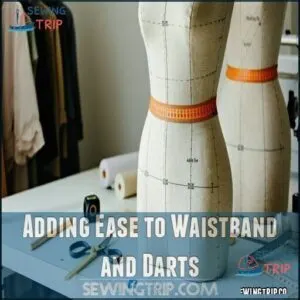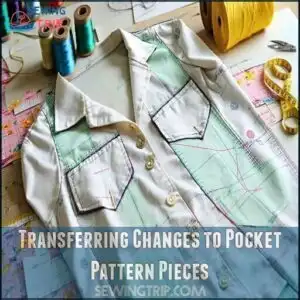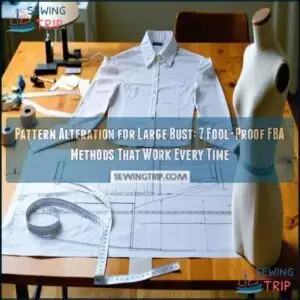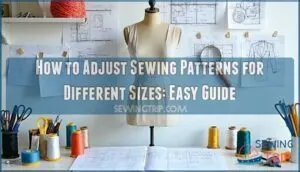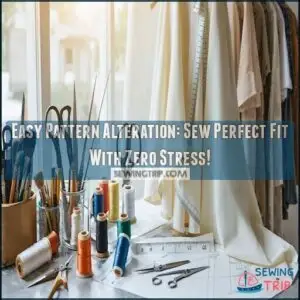This site is supported by our readers. We may earn a commission, at no cost to you, if you purchase through links.
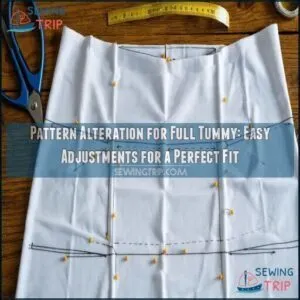
Start by identifying your problem areas—those pulling seams and tight waistbands don’t lie.
On your pattern, create a horizontal cut through the abdomen, leaving hinges at the side seams. Spread the cut to add the needed width, keeping the grainline intact.
Add extra ease to darts or extend the waistband for a smooth fit. Adjust pocket and fly pieces to match the changes.
Think of it as giving your garment the tummy room it’s asking for—because comfort and style should always go hand in hand, ensuring a perfect blend of ease and aesthetics.
Table Of Contents
Key Takeaways
- Identify tummy fit issues like smile lines, gaping pockets, and zipper strain by observing fabric pull or tightness.
- Make precise alterations by creating horizontal cuts, leaving hinges, and adding ease to darts and waistbands for a smooth fit.
- Adjust pocket and fly pieces to match changes, ensuring consistent placement and functional design.
- Use medium-weight, stretchy fabrics like ponte knit or cotton blends for flexibility and to minimize seam strain.
Identifying Full Tummy Needs
You can spot full tummy fit issues by looking for smile lines angling upwards at the crotch or pockets that gape awkwardly.
If your zipper strains or the fabric pulls across the stomach, it’s a clear sign some extra ease is needed.
Recognizing Smile Lines and Pocket Gape
Spotting smile lines and pocket gape is like unraveling a mystery in sewing.
Smile lines and pocket gape reveal the secrets of ill-fitting clothes—unlock the mystery with precise adjustments for a flawless finish.
Smile lines point upwards from the crotch and signal crotch curve issues, while pocket gape screams pocket placement problems.
These tummy fitting issues hint at a need for full tummy alteration.
Factors like posture impact or fabric drape influence can amplify these problems.
Start with muslin fitting analysis to reveal the fit struggles.
Pattern adjustments for tummy ease keep those pockets aligned and guarantee smooth drape, making your garments work with your shape.
Assessing Zipper Strain and Tightness
Tight zipper? That’s a classic sign your garment’s fly front issues need attention.
A tight zipper signals your garment needs a fly-front fix—smooth fabric and strain-free zipping await with the right adjustments.
Zipper stress signs include puckering, pulling tension, or a stubborn zip-up struggle—dead giveaways of tummy fitting issues. To pinpoint strain measurement, test a muslin zipper by observing ease impact.
If the fabric visibly pulls, it’s time for a full tummy adjustment. Altering clothes for tummy comfort means focusing on the pattern’s fullest area.
A well-done full tummy alteration guarantees strain-free wear and seamless pattern fitting solutions—no more awkward zip battles!
If the zipper separates, consider realigning zipper tracks.
Pattern Alteration Basics
Pattern alteration starts with precise Pattern Tracing and removing seam allowances.
Use Line Reinforcement, like tape, to keep cuts stable. For Hinge Creation, cut horizontal and vertical lines at the fullest tummy point, leaving a pivot at the seam intersection.
Add Backing Paper before spreading the cuts—this is called Ease Spreading—to accommodate extra width. Smooth new edges to avoid awkward shaping.
These pattern alteration techniques guarantee better comfort and fit, transforming frustrating sewing patterns into wearable garments with ease and confidence. To guarantee a good fit, record body measurements before starting.
Tracing and Folding Techniques
You’ll start by tracing the pocket outlines and carefully folding back the fly extensions to keep everything tidy.
These steps guarantee accuracy and make it easier to create hinges and spread cuts for the added ease your pattern needs.
Tracing Pocket Outlines and Fly Extensions
When tackling pocket placement for full tummy fitting, start by tracing pocket outlines onto the main pattern for outline accuracy.
Fold the fly extension back, ensuring smooth pattern tracing. Use precision marking techniques with reliable tools like rulers and pencils.
Pattern alteration techniques depend on careful preparation, so master fly extension folding for altering clothes effectively. Consider using a pocket outline pencil for best results.
Small adjustments, big difference, can make a significant impact when using the right tools, such as a pocket outline pencil, and following careful preparation techniques to achieve the desired outcome.
Creating Hinges and Reinforcing Cuts
When tackling pattern adjustments for a full tummy, start by marking hinge placement at the fullest tummy point.
Use precise cutting techniques to create horizontal and vertical cuts, leaving small hinges intact. Reinforcement materials like tape stabilize these cuts, guaranteeing accurate spreading.
Using sharp fabric scissors ensures clean edges during this process.
Securing adjustments with backing paper keeps everything in place, making this sewing pattern alteration seamless for plus-size and full tummy fitting.
Spreading Cuts for Added Ease
Spread cuts with precision to add ease where needed.
Use Horizontal Spreading for width and Vertical Spreading for balance.
Reinforce hinges for control, then slide in Backing Paper to stabilize.
Ease Distribution guarantees a smooth fit for plus size patterns.
Consider products for this method to simplify the process.
Mastering these sewing pattern adjustments gives you confidence to conquer any full tummy adjustment with style and grace.
Executing Adjustments and Ease
You’ll adjust the pattern by adding ease where it’s needed and incorporating it smoothly into existing darts.
Transferring these changes to other pattern pieces guarantees every detail aligns for a polished fit.
Adding Ease to Waistband and Darts
Ease distribution starts with a precise waistband adjustment.
Lower the dart’s center to create flexibility. To refine fit for a full tummy, mark the waistband’s center, measure dart placement, and taper precisely.
Dart manipulation guarantees smooth passages without bulk. For sewing curves, blend patterns subtly, shaping darts as you adjust for ease.
Dart apex placement impacts the final fit. Perfectly sized adjustments transform plus-size patterns flawlessly, ensuring a great fit.
Incorporating Added Ease Into Existing Darts
Transforming your darts is key to ease distribution and style considerations.
To add room for a full tummy, try these steps:
- Shift dart placement by rotating or splitting darts to better distribute ease.
- Blend added ease into the pattern by altering patterns plus size strategically.
- Use dart manipulation for seamless design integration that refines fit and comfort, ensuring a better full tummy fit.
Transferring Changes to Pocket Pattern Pieces
When making a Full Tummy Adjustment, don’t skip transferring pocket changes.
Alter pocket shape, size, and placement for consistency.
Add necessary interfacing and adjust facing for stability.
Here’s your cheat sheet:
| Adjustment Type | Key Focus | Tools Needed | Added Ease (inch/cm) | Tips for Alignment |
|---|---|---|---|---|
| Pocket Shape Alterations | Curved seams | Chalk, scissors | 0.5–1 inch (1.2–2.5 cm) | Match grainline with pattern piece. |
| Pocket Size Adjustment | Seam allowances | Measuring tape, tape | 0.25 inch (0.6 cm) | Reinforce adjusted seams. |
| Facing Adjustments | Fabric stretch | Iron-on interfacing | Not applicable | Prevent pocket gaping. |
| Interfacing Considerations | Pocket opening | Chalk transfer paper | As needed | Align with pocket curves. |
| Pocket Placement Changes | Correct position | Transparent paper, wheel | Variable | Use notches to guide. |
Adjust sewing patterns accurately by refining pocket details—your garments (and you!) will thank you.
Consider exploring resources for pocket pattern alteration to further refine your technique.
Frequently Asked Questions (FAQs)
What is a full belly adjustment?
Picture pants fitting like a snug hug, but pulling uncomfortably at the middle.
A full belly adjustment adds width and length to patterns, relieving tension and ensuring garments fit better around the stomach’s fullest point, which is a crucial aspect of achieving a comfortable fit.
What pattern hides belly fat?
Choose patterns with empire waists, wrap styles, or A-line silhouettes to divert attention upward or elongate your frame.
Designs with ruching or layered fabric also help conceal the midsection, blending style with functional comfort.
How to select fabric for full tummy adjustments?
When selecting fabric, go for medium-weight, stretchy materials like ponte knit or cotton blends with 2-4% spandex.
They provide flexibility for adjustments, support ease, and minimize strain on seams, ensuring a polished, comfortable fit.
Are there alternative methods to Kathleen Cheetham’s approach?
You can try the pivot-and-slide method or slash-and-spread technique.
They’re great for adding ease at the abdomen, and both simplify adjustments without altering pocket lines or seam alignment.
Perfect for quick fixes!
How do you ensure the hem doesn’t ride up?
When hems ride up, it’s like your garment is begging for help.
Add length to the front pattern and adjust for extra tummy ease.
Smooth seams guarantee balance so everything stays exactly where it belongs.
What tools simplify making digital pattern alterations?
Digital tools like Adobe Illustrator or Affinity Designer make pattern alteration a breeze.
They can be paired with a pen tablet for precision, and don’t forget projector-friendly files for easy adjustments—your patterns will thank you!
How to adjust pants without a muslin test?
Skip the muslin by tracing pocket and fly outlines onto your pattern.
Cutting horizontal and vertical adjustment lines at the tummy’s fullest part, spread sections for desired ease, tape, and blend seams smoothly.
Conclusion
Mastering pattern alteration for a full tummy proves that comfort and style can truly go hand in hand.
By addressing fit issues like smile lines, pocket gape, or zipper strain, you guarantee each garment flatters while remaining functional.
Remember, the key lies in creating hinges, spreading the pattern precisely, and adding ease where it’s needed.
Don’t be afraid to experiment—adjustments aren’t setbacks; they’re opportunities to perfect your craft and keep your wardrobe truly yours.
- http://www.craftsy.com/class/plus-size-pant-fitting/5114?_ct=sbqii-sqjuweho-dum&_ctp=11&rceId=1463687917999~49jnsu9m
- https://d.docs.live.net/491a104becd90f99/Documents/Instagram.com/jessawilcox
- https://www.facebook.com/whatjessdoes
- https://www.youtube.com/watch?v=ZzLreAhbTC4
- https://www.coletterie.com/tutorials-tips-tricks/the-colette-patterns-pants-fitting-cheatsheet



